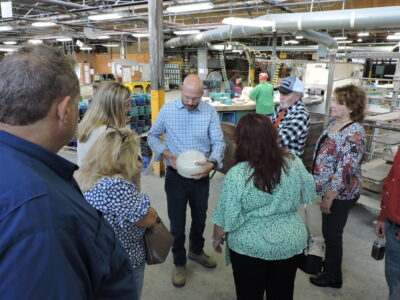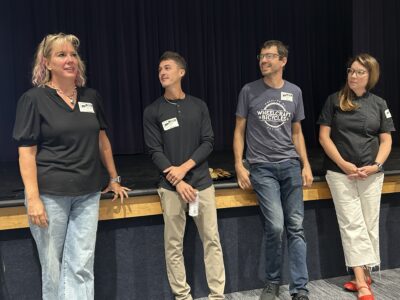National Manufacturing Day Celebrated With Tour of Fiesta Tableware Plant in Newell

photo by: Warren Scott
Public officials, business owners and others observe how Fiesta Tableware is made during a tour of the Newell company’s plant Friday.
NEWELL — Whether in her capacity as president of the Follansbee Chamber of Commerce or as owner of Puskarich Accounting, Debbie Puskarich has worked for several years to raise awareness of the role that manufacturing businesses play in their communities and to make young adults aware of the opportunities they offer.
Puskarich stepped down as chamber president in 2021 and last year turned over the reins of her accounting business to her daughter, Brandy.
But in collaboration with the Business Development Corp. of the Northern Panhandle, she continues to push for awareness of National Manufacturing Day and its role in promoting awareness of the variety of jobs available in that sector of the business world.
In welcoming many to a tour presented Friday morning by officials with the Fiesta Tableware Co., she said her goal all along was to make the community, including local educators and school officials, aware of the many positions that are available at manufacturing businesses in the region.
She noted when possible, the observance of National Manufacturing Day has included a tour of a local manufacturing facility, and she was happy this year to have expanded that practice to Hancock County.
A mix of state and local public officials, business owners, college and public school staff and other citizens observed the many steps taken in the production of the Newell company’s famous colorful dishware.
Matt Wicks, chief operating officer of Fiesta Tableware Co., known for many years as the Homer-Laughlin China Co., told his guests next year will be a big one for the company.
It will mark the 155th anniversary for the business and the 90th anniversary of the product for which it now takes its name.
Wicks, who is the fifth-generation family owner of the business, met the visitors in front of the 120-year-old factory in which the company expanded its operations into West Virginia from East Liverpool in the early 1900s.
He said efforts are being made to consolidate all of the manufacturing operations into the location’s newer plant, which was built in the 1920s.
Wicks and a handful of staff members guided the visitors through the latter building, where they observed people and machinery working together to turn clay and other materials into sturdy, smooth and vibrant plates, bowls, cups and other dishware.
Near the process’ end is a 250-foot-long kiln through which the clay, shaped into assorted dishware and glazed in more than 50 colors, is fired into a highly durable product.
“We have gotten calls from people who have dropped our product on a counter or kitchen floor, chipping them while our dishes are fine,” he said.
Wicks said the line was born during the Great Depression, when the longevity of a product was highly valued.
He said each year, the plant produces 3 million first-quality pieces for sale, through major retail chains or the company’s own direct sales website, in all 50 states, Canada and Mexico.
First quality indicates the product has been thoroughly scanned by staff and deemed acceptable for sale.
Those with imperfections that relegate them to second-quality status are sold at a discount during weekend tent sales held near the plant twice a year.
Wicks said the sales have drawn visitors from as many as 30 states.
He said the company employs nearly 300 people, including about 60 salaried staff in management, sales and accounting, and many laborers who are members of the United Steelworkers of America.
Asked about vacancies, Wicks said there are seven openings on the manufacturing side and about 60 in fulfillment.
He said laborers may train for weeks or months, depending on the position, and the company has employed people from a variety of educational backgrounds.
Visitors viewed a large robotic arm at work during the tour, and Wicks confirmed computer programmers will be needed in the future to serve that element of the operation.
Wicks confirmed many of his staff are older, with a number having opted for retirement during the pandemic, and he’s among many employers in the manufacturing sector who have found a shortage of young adults entering their field.
Brandy Puskarich said of the situation, “Unfortunately, there are several reasons why U.S. manufacturers often struggle to find workers with the right experience or skills. Many applicants lack training in highly automated technology driven machines and robots. There also is a decline in enrollment in vocational or apprenticeship programs.”
“One effective way for manufacturers to partner directly with schools is to create hands-on experiences,” she said.
Puskarich continued, “Manufacturing Day programs allow factories to open their doors to high school and middle school students, letting them see modern robotics, 3-D printing and automation in action. That can break the stereotype that manufacturing is dirty or low-tech.”
Among visitors to the Newell business was Pat Ford, vice president of the West Virginia Polymer Alliance Zone.
A pilot program for the state of West Virginia, the organization is a collective of polymer and related industries striving to expand the manufacturing base in 10 West Virginia counties, from Wheeling to Huntington.
Ford, who once headed the BDC, said the group’s members include businesses involved in polymer or plastic production, recycling and even steelmaking.
“We’re always looking for good people,” he said, adding they have employed people with a variety of skills, including engineers, computer programmers, artisans and laborers.
He said in recent years, colleges and vocational programs have strived to provide the education and training needed for these industries.
“That’s what makes West Virginia unique,” said Ford.
During the tour, Wicks noted the community of Newell grew from the opening of Homer-Laughlin’s plants and until recent years, the business even owned the local water and wastewater treatment systems.
Anthony Clements, current director of the BDC, said manufacturing has played a large part in much of the development of the Ohio Valley and will be key to its future.
“From the historic glass and steel mills that built our towns to today’s advanced manufacturing and industrial innovation, Brooke and Hancock counties have a proud legacy of making things that matter,” he said.
“As we honor this essential sector, the BDC remains committed to fostering a strong, diversified industrial base through strategic partnerships, workforce development and business-friendly initiatives,” said Clements.




